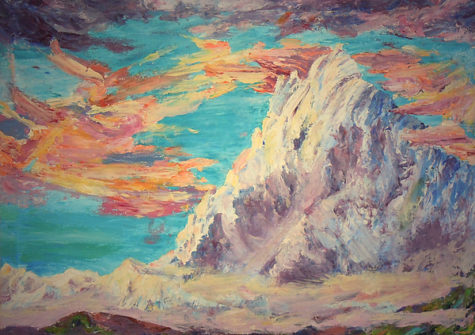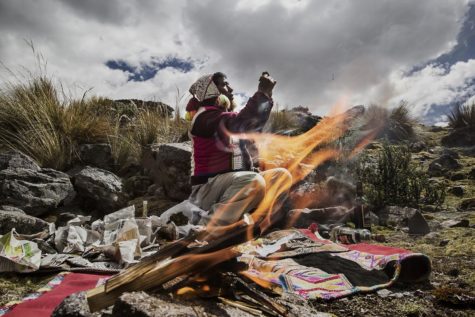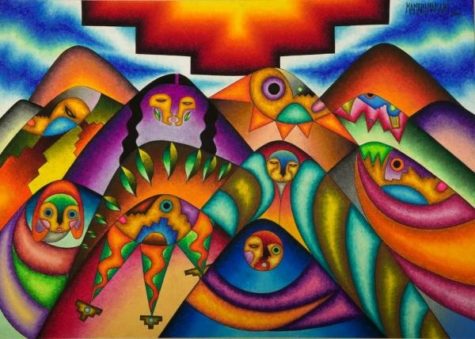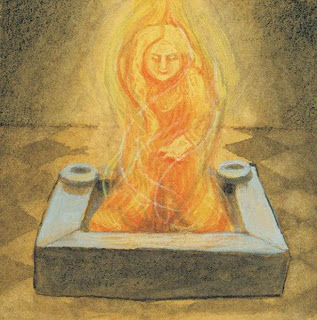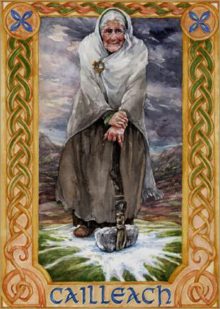Mountain Spirits
In Inca mythology, Apu was the name given to powerful mountain spirits. The Incas also used Apu to refer to the sacred mountains themselves; each mountain had its own spirit, with the spirit going by the name of its mountain domain. An Apu is simultaneously:
- The sacred spirit of a mountain
- The mountain itself
- The spirit who lives atop the mountain.
Paradoxically, the Apu is inseparable from the mountain even though the spirit itself is completely mobile and perfectly capable of traveling far.
Apu literally means “lord.” Female Apus are address as “mama.” Apus were typically male spirits, although some female examples do exist. Female Apus include Mama Simona of Cuzco; Mama Patukusi of Machu Pichu; and Mama Veronica near Cuzco. Her Quechua name is Wakay Willca.
Every mountain peak in the Andes has its own Apu, but the most famous are the twelve associated with Cuzco:
- Apu Ausangate
- Apu Salkanaty
- Mama Simona
- Apu Pikol
- Apu Manuel Pinta
- Apu Wanakauri
- Apu Pachatusan
- Apu Pijchu
- Apu Saqsaywaman
- Apu Wiraqochan
- Apu Pukin
- Apu Senq’a
In the Quechua language—spoken by the Incas and now the second most common language in modern Peru—the plural of Apu is Apukuna.
Manifestation:
Apus frequently take the form of mischievous, playful, but helpful children. For instance, Apu Ausangate, considered the most powerful Apu of Cuzco, manifests as a blond, fair-skinned child wearing white clothes and riding a white horse. Don’t let their chosen form fool you ~ they are ancient and powerful spirits.
Gifts:
Small stones resembling animals or plants are sacred gifts from the Apus and may be used to bring whatever the stone resembles into your life. The resemblance may be enhanced by carving. These gifts are not limited to one person. They may be given to others or passed down through generations of a family. They may also be purchased at Andean pilgrimage sites. Modern versions of these amulets include miniature trucks, tools, and even passports.
Ritual and Offerings:
Travel to the Andes and visit the mountains to request their blessings and protection. Offerings include the following:
- Coca leaves
- Libations of water and alcoholic beverages
One of the most basic concepts of life in the high Andes communities is that of Ayni, or reciprocity, which connotes an ever-shifting, dynamic balance in relationship. This give and take informs not only connections that exist among people, but also the bonds between humans and the natural world, and most especially those between the people and the Apu.
The k’intu offering that reinforces this relationship has the Coca leaf as its main ingredient. Spiritual elders of the villages, or Misayoqs, say that the coca leaf is the favorite food of the Apus.
Three perfect coca leaves are infused with the breath of the Misayoq. This places his intention for the well being of the people into the offering. The k’intu is offered as a sacrament, to ensure his benevolent protection towards the people who dwell in his mighty presence.
An interesting account of an experience of talking with the Apu can be found here. It looks like they also offer trips to Peru, in case you are interested.
About The Inca Mountain Spirits
Inca mythology worked within three realms: Hanan Pacha (the upper realm), Kay Pacha (the human realm), and Uku Pacha (the inner world, or underworld). Mountains—rising up from the human world toward Hanan Pacha—offered the Incas a connection with their most powerful gods in the heavens.
The Apu mountain spirits also served as protectors, watching over their surrounding territories and protecting nearby Inca inhabitants as well as their livestock and crops. In times of trouble, the Apus were appeased or called upon through offerings. It’s believed they predated people in the Andes regions and that they are constant guardians of those who inhabit this area.
Small offerings such as chicha (corn beer) and coca leaves were common. In desperate times, the Incas would resort to human sacrifice.
Juanita—the “Inca Ice Maiden” discovered atop Mount Ampato in 1995 (now on display in the Museo Santuarios Andinos in Arequipa)—may well have been a sacrifice offered to the Ampato mountain spirit between 1450 and 1480.
The Apus in Modern Peru
The Apu mountain spirits did not fade away following the demise of the Inca Empire.
In fact, they are very much alive in modern Peruvian folklore. Many present-day Peruvians, especially those born and raised within traditional Andean communities, still hold beliefs that date back to the Incas (albeit these beliefs are often combined with aspects of Christian faiths, most frequently the Catholic faith).
The notion of the Apu spirits remains common in the highlands, where some Peruvians still make offerings to the mountain gods. According to Paul R. Steele in Handbook of Inca Mythology, “Trained diviners can communicate with the Apus by tossing handfuls of coca leaves onto a woven cloth and studying messages encoded in the configurations of leaves.”
Understandably, the highest mountains in Peru are often the most sacred. Smaller peaks, however, are also venerated as Apus. Cuzco, the former Inca capital, has twelve sacred Apus, including the towering 20,945-foot Ausangate, Sacsayhuamán and Salkantay. Machu Picchu—the “Old Peak,” after which the archeological site is named—is also a sacred Apu, as is the neighboring Huayna Picchu.
Alternative Meanings of Apu
Apu can also be used to describe a great lord or another authority figure. The Incas gave the title Apu to each governor of the four suyus (administrative regions) of the Inca Empire.
In Quechua, Apu has a variety of meanings beyond its spiritual significance, including rich, mighty, boss, chief, powerful, and wealthy.
Sources:
- Encyclopedia of Spirits
- Wayra Peru Travel
- Trip Savvy
Goddess Fuji, also known as Fuchi, is a powerful and almighty goddess of fire. The ancient people of Japan depended on her favor and her strength. The majestic mountain, Fuji was even named after her. Both seem beautiful and soft like a light breeze, but their fire can be very powerful and destructive. Fuji is the goddess of fire; honor her and release her into your life.
Fuji, goddess of fire, is much like her own mountain; she is a volcano. Almost always she is calm and peaceful, but she can unleash a terrible blaze of fire destroying all that stands in her way when angry. Yes, fire can be impossible to beat, but it can also be simple and good. Its energy lights our way, cooks our food, warms and dries us. At times we all enjoy the warm flickering of a fire. Sometimes we love them so much that we imitate them with a gas fire if we don’t have a fireplace. Fuji as a fire goddess can be called upon to help us control the fire that sets so many things ablaze.
Fuji, like everyone else, is not perfect. Take this story, for example. Once the Goddess Fuji was fighting with Mt. Hakusan’s god over whose mountain was taller. Amida Buddha created an ingenuous way to measure: he connected the two mountain peaks with a long pipe and poured water in one end. Fuji was proud until the water came rushing down on her head. However, her humiliation didn’t last long. Fuji struck Mt. Hakusan with eight blows, creating the eight craters near its summit.
You do not need a volcano to honor Fuji. Fuji dwells in the hearth of every home. The hearth or fireplace serves as her altar. Offerings to Fuji include millet, beer, rice beer, and a well tended flame. These offerings may be fed directly to the fire. Your gift can be as simple as a single candle flame.
To honor and respect Fuji, you can use a fire ritual. Ancient fire rituals are almost always associated with women and goddesses. Fire rituals have survived since we first tamed fire to keep warm in caves. The fireplace is still the center of many homes, and candles are still lighted at birthdays and funerals. Fire rituals also exist for cleansing and purifying in traditional and modern medicine.
Known as the woman’s best friend, Fuji protects reproductive health and bestows fertility. An ancient ritual to counteract infertility involved having the barren woman lie on another woman’s fresh afterbirth while a circle of women surrounded her, invoking Fuji’s blessings to allow her to conceive. She also protects children. Fuji’s essence is contained in fireplace ashes. These may be collected into small bags and worn or carried as protective amulets.
From Crystal Vaults and other sources
This Neolithic goddess, known variously as the “blue hag”, the “Bear goddess” and “Boar goddess”, “owl faced”, and “ancient woman”, has survived through the ages. Coming from the continent, Her worship spread to the British Isles early after the recession of the glaciers. The proto-Celtic peoples honored Cailleach and blended Her varying aspects, creating images invoking both love and terror. The various names (see below) that Cailleach has been worshipped in lend a clue to Her wide spread worship:
Names: Beare, Béarra, Béirre, Bhéara, Bheare, Bhéirre, Bhérri, Boi, Bui, Cailliaech, Cailliach, Cailleach Beara, Caillech Bherri, Calliagh Birra, Cally Berry, Carline, Digde, Dige, Dirra, Dirri, Duineach, Hag of Beara, Hag of Beare, Mag-Moullach, Mala Liath, Nicnevin, and Scotia,
Titles: Ancient Woman, Bear goddess, Blue Hag, Boar Goddess, Creator of Storms, Crone, Duineach, Goddess of Sovereignty, Many Followers, Old Woman, Owl Faced, and The Popular
The Cailleach Beara is one of the oldest living mythological beings associated with Ireland. According to the ancient stories, she has a conversation with Fintan the Wise and the Hawk of Achill and both agree that she has outlived them, saying ‘Are you the one, the grandmother who ate the apples in the beginning?’ (apples are associated with immortality and are considered the food of the gods)
The Cailleach Beara is ever-renewing and passes through many lifetimes going from old age to youth in a cyclic fashion. She is reputed to have had at least fifty foster children during her ‘lives’. She usually appears as an old woman who asks a hero to sleep with her, if the hero agrees to sleep with the old hag she then transforms into a beautiful woman.
In Scotland, where she is also known as Beira, Queen of Winter, she is credited with making numerous mountains and large hills, which are said to have been formed when she was striding across the land and accidentally dropped rocks from her apron. In other cases she is said to have built the mountains intentionally, to serve as her stepping stones. She carries a hammer for shaping the hills and valleys, and is said to be the mother of all the goddesses and gods.
She is considered to be the daughter of Grainne, or the Winter Sun. She is affectionately known as ‘Grandmother of the Clanns’ and ‘the Ancestress of the Caledonii Tribe’. The legends of the Caledonii tribe speak of the “Bringer of the Ice Mountains”, the great blue Old Woman of the highlands. Called Cailleach, Cailleach Bheur, Scotia, Carline or Mag-Moullach by the people, She was the Beloved Mountain Giantess who protected the early tribe from harm and nurtured them in Her sacred mountains.
The Cailleach Beara is usually associated with Munster in particular Kerry and Cork. Her grandchildren and great-grandchildren formed the tribes of Kerry and it’s surroundings. And she is considered a goddess of sovereignty giving the kings the right to rule their lands.
Traits and Abilities:
She herds deer. She fights Spring. Her staff freezes the ground.
She is sometimes depicted as an old hag with the teeth of a wild bear and boar’s tusks or else is depicted as a one-eyed giantess who leaps from peak to peak, wielding Her magical white rod and blasting the vegetation with frost. Cailleach’s white rod, or slachdan, made of birch, bramble, willow or broom, is a Druidic rod which gives Her power over the weather and the elements.
Cailleach is also a goddess who governs dreams and inner realities. She is the goddess of the sacred hill, the Sidhe, and the place where we enter into the hidden realm of the Fey and spirit beings. Sacred stones, the bones of the earth, are Her special haunts. Cailleach is connected to the ‘bean sidhe’ or banshee (which means ‘supernatural woman’) who are the wild women of the Fey.
In Scotland, the Cailleachan (‘old women’) were also known as The Storm Hags, and seen as personifications of the elemental powers of nature, especially in a destructive aspect. They were said to be particularly active in raising the windstorms of spring, during the period known as A’ Chailleach.
Là Fhèill Brìghde is the day the Cailleach gathers her firewood for the rest of the winter. Legend has it that if she intends to make the winter last a good while longer, she will make sure the weather on February 1 is bright and sunny, so she can gather plenty of firewood to keep herself warm in the coming months. As a result, people are generally relieved if February 1 is a day of foul weather, as it means the Cailleach is asleep, will soon run out of firewood, and therefore winter is almost over.
On the Isle of Man, where She is known as Caillagh ny Groamagh, the Cailleach is said to have been seen on St. Bride’s day in the form of a gigantic bird, carrying sticks in her beak
On the west coast of Scotland, the Cailleach ushers in winter by washing her great plaid (tartan) in the Whirlpool of Coire Bhreacain (cauldron of the plaid). . This process is said to take three days, during which the roar of the coming tempest is heard as far away as twenty miles inland. When she is finished, her plaid is pure white and snow covers the land.
Cailleach is also the guardian spirit of a number of animals. She is associated with the ancient tradition of herding reindeer. This means that the reindeer (and all deer) are Her cattle; She herds and milks them and often gives them protection from hunters. Swine, wild goats, wild cattle, and wolves are also Her creatures. Cailleach is also a fishing goddess, as well as the guardian of wells and streams.
Related Content:

